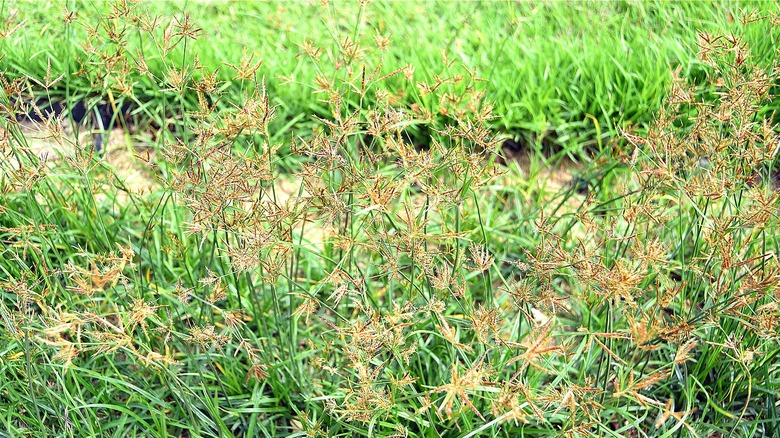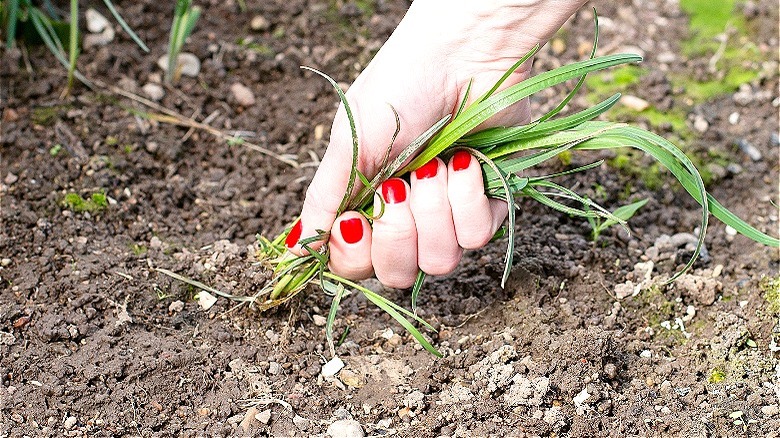If your lawn is starting to look a bit rough as the summer rolls on, take a closer look at what’s growing alongside the blades of grass. It could be nutsedge, a type of fast-growing lawn weed that can grow in plain sight and, before you know it, turn into an infestation. Nutsedge’s ability to camouflage itself is what makes it initially difficult to spot and subsequently treat, but it is treatable.
Typically, if just a small amount of nutsedge is growing on your lawn — and you catch it soon enough — just plucking or pulling it out from the stem will be enough to bring the infestation under control. Other times, however, you’ll need to use the right type of herbicide to treat your lawn. Many natural treatments simply don’t work well on this particular type of lawn weed.
How to spot nutsedge? Though it can easily blend into the turf, you’ll eventually notice that nutsedge “blades” tend to be taller than the surrounding grass once it grows. It’s also thicker and its appearance will ultimately stand out against the uniformity of your lawn. If you suspect the perennial weed is present, be aggressive in removing it.
Consider what makes nutsedge a formidable enemy

It’s often difficult to see nutsedge growing, and as a result, you may go on with your routine lawn care, cutting the weed alongside the grass, yet that will only allow nutsedge to spread even faster. Your first task, then, is to spot it right away. Most often, the blades of the weed will be long and grass-like, but also a bright green color. They also have a very pointy top (but that may not be the case if you’ve recently cut the area with the mower). Another form of nutsedge is yellow nutsedge, which has a bit of a yellow tint to the green. A third type has a red-purple hue to it (seen above).
The second problem is how this weed spreads. Unlike typical grasses that go to seed, nutsedge spreads both through seed and tubers. Called nutlets, these small tube structures grow underground, which gives them the ability to flourish without being too noticeable. This also makes them much harder to get rid of than other weeds with a simpler root system.
Also, note that this weed tends to grow quickly, recovering well and fast after mowing. It also tends to push through mulch, bark, and other materials in flower beds. To eradicate your yard of nutsedge infestation, you’ll need to remove all components of the plant and then treat the area properly.
How to get rid of nutsedge infestations

To eradicate this pesky weed from your yard, start with the patches. To do this, grab nutsedge by its base (with gloves on so you avoid slicing your finger on the sometimes sharp blades, and then pull upward in a hard motion. This will help to pull the entire plant out, including the root system and tubers attached to it.
Chemical control of nutsedge is often necessary if there’s infestation. However, as said, most types of natural herbicides are ineffective against nutsedge because they lack enough potent protection. Instead, seek out a product that contains halosulfuron. This is an active ingredient in a select few herbicides but a potent tool for getting rid of this persistent weed. Other helpful ingredients include dichlobenil, glyphosate, and sulfosulfuron. Some over-the-counter brands that may help include Casoron and Sedgehammer; other products may be available from a professional landscaper and lawn treatment specialist. Follow the manufacturer’s directions on how to use these products properly.
It’s also a good idea to work to prevent nutsedge from coming back. To do that, ensure good water drainage in your yard after it rains since this weed tends to thrive in very wet conditions. Further, overseed the lawn to keep it thick, preventing weeds from having enough room to germinate.
